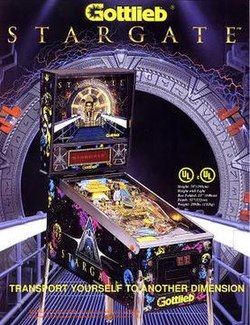Description
A "pyramid" is the main feature of this game. It has a top that opens by raising and lowering. A moving "Glidercraft" ship will be extended from the pyramid when the pyramid is open. The "Glidercraft" will zigzag left-right, in front of the pyramid, with about 90 degrees of horizontal movement. [1]
This game also features two "Horus" targets. These are basically the reverse of drop targets: they are targets that, rather than dropping down into the playfield when hit, rise up into the air. Each target is attached to a large "Horus" structure, which is itself attached to a pivot that can raise and lower. These Horus structures drop down to block the player from reaching two key shots. The game occasionally raises them, allowing the player to temporarily make the shots. Part of the development involved having actor James Spader record the voice parts of the Stargate character Daniel Jackson. [1]
This page is based on this
Wikipedia article Text is available under the
CC BY-SA 4.0 license; additional terms may apply.
Images, videos and audio are available under their respective licenses.
